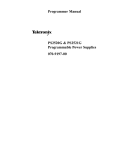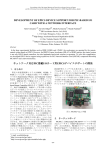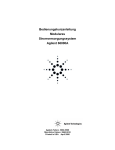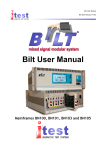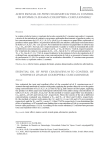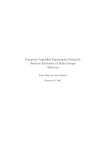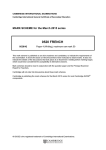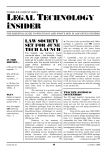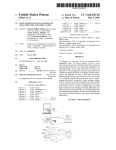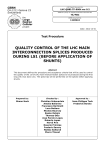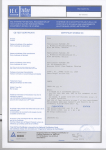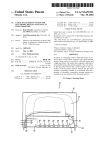Download Digital power manager for controlling and monitoring an array of
Transcript
US007394445B2 (12) United States Patent Chapuis et a1. DIGITAL POWER MANAGER FOR CONTROLLING AND MONITORING AN ARRAY OF POINT-OF-LOAD REGULATORS CN 2521825 (Continued) OTHER PUBLICATIONS “Synchronization of Multiple Voltage Regulator Outputs,” by M.W. USC 154(b) by 125 days. Mueller et a1. IBM Technical Disclosure Bulletin, Jun. 1999; (2 (21) Appl. No.: 11/048,014 Filed: 11/2002 Subject to any disclaimer, the term of this patent is extended or adjusted under 35 This patent is subject to a terminal dis claimer. (22) (65) *Jul. 1, 2008 FOREIGN PATENT DOCUMENTS Inventors; Alain Chapuis, Morgan Hill, CA (US); Mikhail Guz, Daly City, CA (US) Assignee: Power-One, Inc., Camarillo, CA (US) Notice: US 7,394,445 B2 (10) Patent N0.: (45) Date of Patent: pages). (Continued) Primary ExamineriVijay Shankar (74) Attorney, Agent, or Firm4O’Melveny & Myers LLP Jan. 31, 2005 Prior Publication Data US 2006/0015616 A1 (57) ABSTRACT Jan. 19, 2006 Related US. Application Data (63) Continuation-in-part of application No. 10/326,222, ?led on Dec. 21, 2002, noW Pat. No. 7,000,125, Which is a continuation-in-part of application No. 10/293, 001, ?led on Nov. 13, 2002, noW Pat. No. 7,049,798, Which is a continuation of application No. 10/293,531, ?led on Nov. 12, 2002, noW Pat. No. 6,949,916. A poWer control system comprises a plurality of point-of-load (POL) regulators each adapted to convey regulated poWer to a load, a serial data bus operatively connecting the plurality of POL regulators, and a digital poWer manager connected to the data bus. The digital poWer manager includes a controller adapted to execute stored instructions to program operational Provisional application No. 60/588,594, ?led on Jul. parameters of the plurality of POL regulators via the serial data bus and receive monitoring data from the plurality of POL regulators via the serial data bus. The digital poWer 16, 2004. manager further comprises a user interface, such as an 12C (51) Int. Cl. and send monitoring data thereto. The digital poWer manager further comprises a non-volatile memory containing a plural (52) US. Cl. ......................... .. 345/89; 345/95; 345/204; (60) interface, adapted to receive programming data therefrom G09G 3/36 (2006.01) 345/210; 345/211; 345/212 (58) Field of Classi?cation Search ......... .. 345/89*103, 345/204i2l5; 713/300, 310, 3304340; 323/282 See application ?le for complete search history. (56) References Cited U.S. PATENT DOCUMENTS 429,581 A ity of registers, including a digital poWer manager con?gura tion register containing data values de?ning a con?guration of the poWer control system, a POL set-up register containing data values re?ecting programming state of one of the POL regulators, a POL monitor register containing data values re?ecting status of operating conditions Within one of the POL regulators, and a user-de?nable space. The digital poWer manager is adapted to program voltage margining of each of the POL regulators. 6/1890 Tan 37 Claims, 7 Drawing Sheets (Continued) 1o \\ Board SD Line OKA OKB OKC OKD V01 Vo n Core V01 V0 n l/Os V01 Vo n Interface 1 V01 V0 n Interface 2 US 7,394,445 B2 Page 2 US. PATENT DOCUMENTS 3,660,672 4,194,147 4,204,249 4,328,429 4,335,445 4,350,943 4,451,773 4,538,073 4,538,101 4,616,142 4,622,627 4,630,187 4,654,769 4,677,566 4,761,725 4,940,930 4,988,942 5,004,972 5,053,920 5,073,848 5,079,498 5,117,430 5,168,208 5,229,699 5,270,904 5,272,614 5,287,055 5,349,523 5,377,090 5,426,425 5,481,140 5,489,904 5,532,577 5,627,460 5,631,550 5,646,509 5,675,480 5,727,208 5,752,047 5,815,018 5,847,950 5,870,296 5,872,984 5,874,912 5,883,797 5,889,392 5,892,933 5,905,370 5,917,719 5,929,618 5,929,620 5,935,252 5,943,227 5,946,495 5,990,669 5,994,885 6,021,059 6,055,163 6,057,607 6,079,026 6,100,676 6,111,396 6,115,441 6,121,760 6,137,280 6,150,803 6,157,093 6,157,182 6,163,143 6,163,178 6,170,062 A A A A A A A A A A A A A A A A A A A A A A A A A A A A A A A A A A A A A A A A A A A A A A A A A A A A A A A A A A A A A A A A A A A A A A B 5/1972 3/1980 5/1980 5/1982 6/1982 9/1982 5/1984 8/1985 8/1985 10/1986 11/1986 12/1986 3/1987 6/1987 8/1988 7/1990 1/1991 4/1991 10/1991 12/1991 1/1992 5/1992 12/1992 7/1993 12/1993 12/1993 2/1994 9/1994 12/1994 6/1995 1/1996 2/1996 7/1996 5/1997 5/1997 7/1997 10/1997 3/1998 5/1998 9/1998 12/1998 2/1999 2/1999 2/1999 3/1999 3/1999 4/1999 5/1999 6/1999 7/1999 7/1999 8/1999 8/1999 8/1999 11/1999 11/1999 2/2000 4/2000 5/2000 6/2000 8/2000 8/2000 9/2000 9/2000 10/2000 11/2000 12/2000 12/2000 12/2000 12/2000 1/2001 Berger et al. Payne et al. Dye et al. Kublick et al. Nercessian Pritchard Papathomas et al. Freige et al. Shimpo et al. Upadhyay et al. Rodriguez et al. Henze Middlebrook Whittaker et al. Henze Detweiler Ekstrand Roth Staf?ere et al. Steigerwald et al. Cleasby et al. Berglund Schultz et al. Chu et al. Gulczynski Brunk et al. Cini et al. Inou et al. Steigerwald Conrad et al. Maruyama et al. Hadidi Doluca Bazinet et al. Castro et al. Berglund et al. Stanford Brown Darby et al. Soborski Bhagwat Schaffer Berglund et al. Hasegawa Amaro et al. Moore et al. Voltz Bryson Hoffman et al. Boylan et al. Dobkin et al. Berglund et al. Bryson et al. Scholhamer et al. Brown Wilcox et al. Kennedy Wagner et al. Rader, III et al. Berglund et al. Burstein et al. Line et al. Douglass et al. Marshall et al. Ackermann Varga Giannopoulos et al. Tanaka et al. Shimamori Stark et al. Henrie 6,177,787 6,181,029 6,191,566 6,194,883 6,198,261 6,199,130 6,208,127 6,211,579 6,246,219 6,249,111 6,262,900 6,288,595 6,291,975 6,304,066 6,304,823 6,320,768 6,351,108 6,355,990 6,366,069 6,373,334 6,385,024 6,392,577 6,396,169 6,396,250 6,400,127 6,411,071 6,411,072 6,421,259 6,429,630 6,448,745 6,456,044 6,465,909 6,465,993 6,469,478 6,469,484 6,476,589 6,556,158 6,563,294 6,583,608 6,590,369 6,608,402 6,621,259 6,683,494 6,686,831 6,693,811 6,717,389 6,731,023 6,744,243 6,771,052 6,778,414 6,788,033 6,788,035 6,791,298 6,791,302 6,791,368 6,795,009 6,801,027 6,807,070 6,816,758 6,819,537 6,828,765 6,829,547 6,833,691 6,850,046 6,850,049 6,850,426 6,853,169 6,853,174 6,888,339 6,903,949 6,911,808 6,915,440 6,917,186 1/2001 1/2001 2/2001 2/2001 3/2001 3/2001 3/2001 4/2001 6/2001 6/2001 7/2001 9/2001 9/2001 10/2001 10/2001 11/2001 2/2002 3/2002 4/2002 4/2002 5/2002 5/2002 5/2002 5/2002 6/2002 6/2002 6/2002 7/2002 8/2002 9/2002 9/2002 10/2002 10/2002 10/2002 10/2002 11/2002 4/2003 5/2003 6/2003 7/2003 8/2003 9/2003 1/2004 2/2004 2/2004 4/2004 5/2004 6/2004 8/2004 8/2004 9/2004 9/2004 9/2004 9/2004 9/2004 9/2004 10/2004 10/2004 11/2004 11/2004 12/2004 12/2004 12/2004 2/2005 2/2005 2/2005 2/2005 2/2005 5/2005 6/2005 6/2005 7/2005 7/2005 Hobrecht Berglund et al. Petricek et al. Shimamori Schultz et al. Berglund et al. Doluca Blair Lynch et al. Nguyen Suntio Hirakata et al. Snodgrass WilcoX et al. Smit et al. Pham et al. Burstein et al. Mitchell Nguyen et al. Melanson Olson Swanson et al. Voegli et al. Bridge Giannopoulos Schultz Feldman Brooks et al. Pohlman et al. Killat Darmawaskita Soo et al. Clarkin et al. Curtin L’Hermite et al. Umminger et al. Steensgaard-Madsen Duffy et al. Zafarana et al. Burstein et al. Soo et al. Jones et al. Stanley Cook Bowman et al. Johnson Rothleitner et al. Daniels et al. Ostojic Chang et al. Vinciarelli Bassett et al. Shenai et al. Tang et al. Tzeng et al. Duffy et al. Hann et al. Ribarich Maxwell, Jr. et al. Pohlman et al. Schultz et al. Law et al. Chapuis Chapuis Kono Koj ori et al. Burstein et al. Inn Travaglini et al. Ribarich Shimamori Berglund et al. Klippel et al. US 7,394,445 B2 Page 3 6,928,560 B1 8/2005 Fell, III et al. 6,933,709 B2 8/2005 Chapuis 6,933,711 B2 8/2005 Sutardja et a1. 6,936,999 B2 8/2005 Chapuis 6,947,273 B2 6,963,190 B2 6,965,220 B2 9/2005 Bassett et al. 11/2005 Asanuma et al. 11/2005 Kernahan et al. 6,965,502 B2 6,975,494 B2 6,977,492 B2 11/2005 Duffy et a1. 12/2005 Tang et al. 12/2005 Sutardja et a1. 7,000,125 B2 * 2/2006 Chapuis et al. ........... .. 713/300 7,007,176 B2 7,023,672 B2 2/2006 Goodfellow et al. 4/2006 Goodfellow et al. 7,049,798 B2 * 5/2006 Chapuis et al. ........... .. 323/282 7,068,021 B2 6/2006 Chapuis 7,080,265 B2 7,141,956 B2 2001/0033152 2001/0052862 2002/0070718 2002/0073347 2002/0075710 2002/0105227 2002/0144163 2003/0006650 2003/0067404 2003/0122429 2003/0142513 2003/0201761 2004/0027101 2004/0080044 2004/0090219 2004/0093533 2004/0123164 2004/0123167 2004/0135560 2004/0155640 2004/0174147 A1 A1 A1 A1 A1 A1 A1 A1 A1 A1 A1 A1 A1 A1 A1 A1 A1 A1 A1 A1 A1 2004/0178780 A1 2004/0189271 A1 7/2006 Thaker et a1. 11/2006 Chapuis 10/2001 12/2001 6/2002 6/2002 6/2002 8/ 2002 10/ 2002 Pohlman et al. Roelofs Rose Zafarana et a1. Lin et al. Nerone et a1. Goodfellow et al. 1/2003 Tang et al. 4/ 2003 Ruha et al. 7/2003 Zhang et a1. 7/ 2003 10/ 2003 2/ 2004 4/ 2004 Vinciarelli Harris Vinciarelli Moriyama et al. Data Sheet, Integrity-One Power SystemiRack System Power-One, Inc. (P025580-P025583). Data Sheet, “PCS Controller” Power-One, Inc. (P025584-P025585). Data Sheet, “PMP 25 Recti?er Module” Power-One, Inc. (P025602 P025603). “Presenting DALI” AG DALI, 2003, pp. 1-17. “DALI Manual” DALI AG, Digital Addressable Lighting Interface Activity Group, ZVEI-Division Luminaires, 2001,pp. 1-62. “Microchip PIC 16C781/782 Data Sheet, 8-bit CMOS Microcontrol lers with ND, D/A, OPAMP, Comparators and PSMC” Microchip Technology Inc., 2001, pp. 1-184. “Microchip AN811, The RS-232/DALI Bridge Interface” Microchip Technology Inc., 2002, DS00811A, pp. 1-8. “Microchip AN809, Digitally Addressable DALI Dimming Ballast” Microchip Technology Inc., 2002, DS00809B, pp. 1-18. “The Digital Addressable Lighting Interface (DALI): An Emerging Energy-Conserving Lighting Solution” by Ronat, Odile International Recti?er, Apr. 9, 2002, TP4/9/2002, pp. 1-6. “Microchip AN703, Using the MCP320X 12-Bit Serial ND Con verter with Microchip PICmicro® Devices” Microchop Technology Inc., 2002, DS00703A, pp. 1-25. “System Management Bus (SMBus) Speci?cation” Version 2.0 Duracell, Inc., Energizer Power Systems, Inc., Fujitsu, Ltd., Intel Corporation, Linear Technology, Inc., Maxim Integrated Products, Mitsubishi Electric Semiconductor Company, PowerSmart, Inc., Toshiba Battery Cd. Ltd., Unitrode Corporation, USAR Systems, Inc., Aug. 3, 2000, pp. 1-59. “Fieldbus System Engineering Guidelines” Fieldbus Foundation, 2003-2004, pp. 1-94. “Technical Overview, FoundationTM ?eldbus, Freedom to Choose. Power to Integrate” Fieldbus Foundation, 2003, FD-043 Rev 3.0, pp. 5/ 2004 Chapuis 1-37. 5/ 2004 Chapuis et al. 6/ 2004 Chapuis et al. “Silicon Labs Preliminary Invalidity Contentions”, Civil Action No. 2-05-CV-463 (LED)iMay 26, 2006 (US. District Court Eastern District of Texas). 6/ 2004 Chapuis 7/ 2004 Kernahan et al. 33702 Microprocessor Power Supply (3.0A) Analog Products 8/ 2004 Sutardja et a1. 9/ 2004 Vinciarelli 9/2004 Chapuis MC33702 Fact Sheet; Motorola/Digital dna/ Power Management Switching; pp. 1-4. “Motorola Switch Mode Power Supply With Multiple Linear Regu lators And High Speed CAN Transceiver” Motorola, Inc. 2002; digi 9/2004 Hansson et al. Templeton ................. .. 307/11 tal dna; Analog Marketing; Rev. 2.5, Nov. 2002; 33394; Multi-Output 2004/0201279 A1* 10/2004 2004/0225811 A1 11/2004 Fosler Power Supple Semiconductor Technical Data. 2004/0246754 A1 12/2004 Chapuis “Power Management Solutions For Networking Aplications”; Pre sented by Luc Darmon Smart Networks Developer Forum 2003iJun. 4-6 Euro-Disney Paris, France; Motorola digital dna; 2005/0093594 A1 2005/0117376 A1 5/2005 Kim et al. 6/2005 Wilson 2005/0146312 A1 2005/0200344 A1 2006/0022656 A1 7/2005 Kennyetal. 9/2005 Chapuis 2/2006 Leung et a1. 2006/0149396 A1 * 7/2006 Templeton ................. .. 700/22 FOREIGN PATENT DOCUMENTS EP EP EP EP EP JP KR RU SU WO W0 WO WO WO WO 0255258 315366 0660487 0875994 0997825 1185329 200284495 1814177 A1 1359874 WO93/19415 WO 01/22585 A1 WO02/31943 WO02/31951 WO02/50690 WO02/063688 2/1988 5/1989 6/1995 11/1998 5/2000 3/1999 8/2002 5/1993 12/1985 9/1993 3/2001 4/2002 4/2002 6/2002 8/2002 OTHER PUBLICATIONS “Power System Controller in an Intelligent Telecom Recti?er Plant,” by U. Roth. INTELLEC 1992, pp. 476-483. Integrity-One: Installation, Operation and Maintenance Manual Power-One, Inc., 1999-2003 Version 1.2 (P025374-P025559). www.motorola.com/sndf; pp. 1-26. Preliminary Information 1.5 A Switch-Mode Power Supply With Linear Regulator 33701; Power Supply Integrated Circuit; Motorola Semiconductor Technical Data; Analog Marketing MC33701/D Rev. 1.0, May 2003; Motorola digital dna; pp. 1-24. “Electronic Products” Power Supply Special The Engineer’s Maga zine of Product Technology, A Hearst Business Publication, vol. 37, No. 10, Mar. 1995, 4 pages. “KEKB Power Supply Interface Controller Module” byA. Akiyama, T. Nakamura, M. Yoshida, T. Kubo, N. Yamamoto and T. Katoh. KEK, High Energy Accelerator Research Organization, 1-1 Ohio, Tsukuba 305 Japan, International Conference on Accelerator and Large Experimental Physics and Control Systems, 1997, Beijing, China, 4 pages. “Magnet Power Supply Control System in KEKB Accelerators” by T.T. Nakamura, A. Akiyama, T. Katoh, Ta. Kubo, N. Yamamoto, M. Yoshida. KEK, Tsukuba, Japan International Conference on Accel erator and Large Experimental Physics Control Systems, 1999, Trieste, Italy, pp. 406-408. “System Management Bus Speci?cation” Smart Battery System Speci?cations, Revision 1.1, Dec. 11, 1998 Copyright 1996, 1997, 1998, Benchmarq Microelectronics Inc., Duracell Inc., Energizer Power Systems, Intel Corporation, Linear Technology Corporation, Maxim Integrated Products, Mitsubishi Electric Corporation, National Semiconductor Corporation, Toshiba Battery Co., Varta Batterie AG, All rights reserved, 39 pages. “The I2C-Bus Speci?cation” Version 2.1, Jan. 2000, Document Order No. 9398 393 40011, pp. 1-46. US 7,394,445 B2 Page 4 “Quantization Resolution and Limit Cycling in Digitally Controlled “DHP Series DC Power Supplies”, IEEE 488.2/RS-232 Options PWM Converters” by Angel V. Peterchev andA.V. Sanders Electrical Programming Manual, Sorensen, Division of Elgar Electronics Cor Engineering and Computer Science; US Berkley; Power Electronics Specialists Conference 2001.PESC, vol. 2, Jun. 17-21, 2001, pp. poration, Document No. M550005-01 Rev B, Jul. 29, 2002, 32 pages. “Distributed Power Hot Swap Controller” SMH4804 Summit Micro electronics, Inc., 2050 2.3, Mar. 19, 2001, 32 pages. “Programmer Manual”, PS2520G & PS2521G Programmable Power 465-471; XP002274573. “Distributed Intelligence and Modular Architecture for Next Genera tion DC Power System” by Louis Duguay and Pierre Got Astec Advanced Power Systems, Quebec, Canada; 6 pgs. Ron Vinsant, John DiFiore, and Richard Clarke PCIM, Jun. 1994, pp. Supples, Tektronix, 070-9197-00, 1995, 70 pages. “User Manual”, PS2520, PS2520G, PS2521 & PS2521G Program mable Power Supples, Tektronix, 070-9196-00, 1995, 56 pages. “A Power LAN for Telecommunication Power Supply Equipment” 30-37. by Nicholas Vun C.H., Lau CT. and Lee B.S. IEEE TENCON ’93 “Operating and Service Manual”, SBC488A, Magna-Power Elec tronics, Inc., Dec. 19, 2002, 58 pgs. “Operating and Service Manual”, SQ Series, DC Power Supples Magna-Power Electronics, Inc., Dec. 16, 2002, 48 pgs. “Uniform Language for Accessing Power PlantsiHuman-Machine Beihing, pp. 24-27. “VXI Bus Programmable DC Power Supplies” Advanced Power “Digitally-Controlled SMPS Extends Power System Capabilities” by Language”, ANSI T1.317-1993 American National Standards Insti tute, Dec. 14, 1993, 55 pages. Designs, Inc., Irvine, CA; 4 pages. “Operating Manual for Internal RS -232 Interface for XT 60 Watt and HPD 300 Watt Series Programmable DC Power Supplies” Xantrex “An Intelligent, Fault Tolerant, High Power, Distributed Power Sys tem for Massively Parallel Processing Computers” by J. Burns, J. Riel andT. TiBene IEEE, May 1994, 0-7803-1456-5/94, pp. 795-800. Technology, Inc., 59 pages. “Auto Sequence Programming Examples for GPIB-M” Xantrex Technology, Inc., Nov. 27, 2002, 1.0a, 4 pages. “SCPI Programming Examples for GPIB-M” Xantrex Technology, Inc., Nov. 26,2002, 1.0, 3 pages. “BE510 / BE510S Modules”iBipolar DC Source from 100mV to 20V and from 100nA to 4A Innovative Test Systems; BE510 Version “Implementing a Nationwide Energy Management System” by Stig Sj oberg, Tommy Hedberg, Lars Selberg and Rober Wikstrom. II, Issue 9, Nov. 12, 2000, 3 pgs. “IEEE Standard Codes, Formats, Protocols, and Common Com mands for User with IEEE Std 488.1-1987, IEEE Standard Digital Interface for Programmable Instrumentation”, IEEE Std 488.2-1992 IEEE, Jun. 18, 1992, ISBN 1-55937-238-9, 254 pages. “BE52x Modules”iMulti-range bipolar DC sources from 30V to 500V, 90W Innovative Test Systems; BE52x Version A, Issue 9, Aug. 3,2001, 3 pages. “PCX-150A 150 Amp Pulsed Current Source Operation Manual”, Version 3.0 Directed Energy, Inc., 2001, Document No. 9100-0212 R4, 31 pages. “New Applications Demand Programmable Power Supplies/ Sources” by Paul O’Shea http://www.evaluationengineering.com/ archiv/aIticles/0997powr.htm, Nelson Publishing, Inc., 1997, 8 pages. “Market Trends Toward Enhanced Control of Electronic Power Sys tems” by FM. Miles, R.K. Danak, T.G. Wilson and G.G. Suranyi IEEE, 1993, 0-7803-0982-0/93, pp. 92-98. “R Option, S Option DC Power Supplies”, IEEE 488.2/RS-232 Pro gramming Manual Power Ten, Document No. M550013-01 Rev C, Jun. 25, 2002, 56 pages. “A Digitally Controlled Zero-Voltage-Switched Fullbridge Con verter” by Karl-Heinz Rinne, Klaus Theml, Joseph Duigan and Oliver McCarthy Power Conversion, Jun. 1994 Proceedings, pp. “Agilent E3640A-E3649A Programmable dc Power Supplies” Data Sheet Agilent Technologies, 4 pages. “Agilent E364xA Single Output DC Power Supplies”, User’s Guide Agilent Technologies, Part No. E3640-90001, Jan. 2000, 207 pages. “Optimizing Power Product Usage to Speed Design Validation Test ing” Application Note 1434 Agilent Technologies, Nov. 22, 2002, 16 pages. “vol. 2: Command Reference” SCPI Consortium, May 1999, Version 1999.0, 565 pages. “Why have Monitoring?” by P. Shawyer, P Hobbs and A. McLeod Texcel Technology PLC, United Kingdom. “IMPI Intelligent Platform Management Bus Communications Pro tocol Speci?cation v1.0” Intel, Hewlett-Packard, NEC, Dell, Docu ment Revision 1.0, Nov. 15, 1999, 39 pages. “Operating and Service Manual”, MQ Series DC Power Supplies Magna-Power Electronics, Inc., Dec. 19, 2002, 48 pages. 3 17-3 24. “User’s Guide” Series 661xxA MPS Power Modules & Model “vol. 1: Syntax and Style” Standard Commands for Programmable Instruments (SCPI) Consortium, May 1997, Version 1997.0, 68 66001A MPS Keyboard Agilent Technologies, Agilent Part No. 5959-3386, Apr. 2000, 53 pages. pages. “Programming Guide” Series 661xxA MPS Power Modules Agilent “Integrate Internet Solutions Into Your Energy Management Net work” by Johan Sarkinen and Ola Lundin Jun. 1998, 7 pages. “Automating the Design of a Generic Modular Power System for the Technologies, Agilent Part No. 5959-3362, Sep. 1997, 114 pages. "Accelerator-Control-System Interface for Intelligent Power Sup Global Market” by George Pedersen, Steve Briggs, and Paul Massey Advance Power Raynham Road, Bishops Stortford, Herts.; CM23 5PF UK. “An Operation and Maintenance Process Model for Energy Manage ment” by Ola Lundin Ericsson Components AB, Energy Systems Division, S-164 81 KISTAiStockhold, Sweden; 7 pages. “Intelligent Platform Management Interface Speci?cation v1.5” Intel, Hewlett-Packard, NEC, Dell, Document Revision 1.1, Feb. 20, 2002, 459 pages. “vol. 2: Command Reference” SCPI Consortium, May 1997, Version 1997.0, 506 pages. “vol. 4: Instrument Classes” SCPI Consortium, May 1997, Version 1997.0, 58 pages. plies” by S. Cohen Los Alamos National Laboratory, pp. 183-186. “Testing Intelligent Power Supplies for the Los Alamos National Laboratory Accelerator Complex” by J .C. Sturrock, S. Cohen, B.L. Weintraub, D.J. Hayden and SF. Archuletta Los Alamos National Laboratory, pp. 217-219. “Intelligent Power Supply Controller” by RS. Rurnrill and DJ. Reinagel IEEE, Aug. 1991, 0-7803-0135-8/91, PAC 1991, pp. 1537 1539. “Magnet Power Supply as a Network Object” by S. Cohen and R. Stuewe IEEE, Aug. 1991, 0-7803-0135-8/91, PAC 1991, pp. 929 931 . 1999.0, 67 pages. “Non-Impact Printer Power and Motor Control System on a Chip” by James Masson and Steven Barrow IEEE, Apr. 1995, IEEE Catalogue No. 95TH8025, 0-7803-2423-4/95, pp. 98-103. “Power Distribution Systems for Future Homes” by Po-Wa Lee, Yim-Shu Lee and Bo-Tao Lin IEEE, Aug. 1999, 0-7803-5769-88/99, “vol. 3: Data Interchange Format” SCPI Consortium, May 1997, pp. 1140-1146. “vol. 1: Syntax and Style” SCPI Consortium, May 1999, Version Version 1997.0, 73 pages. “Installation Guide” MPS Mainframe Model 66000A Agilent Tech “vol. 3: Data Interchange Format” SCPI Consortium, May 1999, nologies, Agilent Part No. 66000-90001, Apr. 2000, 26 pages. Version 1999.0, 72 pages. “vol. 4: Instrument Classes” SCPI Consortium, May 1999, Version 1999.0, 115 pages. “Service Guide for Agilent 6610xA Power Modules” Agilent Tech by Ueli Roth IEEE, Aug. 1992, 0-7803-0779-8/92, pp. 476-483. “The Continuing Evolution of Intelligence for Telecommunications Power Plants” by Jimmy Godby IEEE, Apr. 1996, 0-7803 -3 507-4/96, nologies, Agilent Part No. 5959-3364, Dec. 2002, 101 pages. pp. 70-75. “Power System Controller in an Intelligent Telecom Recti?er Plant” US 7,394,445 B2 Page 5 “Digitally Controlled Power Systems: How Much Intelligence is Needed and Where it Should be” by Tom Lock RELTEC Corpora tion, 5 pages. “Controlling and Alarming DC Power Plants via the Internet” by Anthony P. Cosentino, Michael C. Sullivan, RichardV. Baxter, Jr. and John Loeck Power Conversion Products, LLC and Pensar Corpora tion, 6 pages. “Defendant’s Artesyn Technologies, Inc.’s Preliminary Invalidity Contentions”4(PoWer- One, Inc. vs. Artesyn Technologies, Inc et al.) Civil Action No. 2-05-CV-463 (LED), United States District Court for the Eastern District of Texas; Apr. 26, 2006. 25 Watt DC-DC Converters Melcher The Power Partners and Power One Group of Companies, Industrial Environment, Apr. 4, 1999, DC-DC Converters <40 Watt, G Series, 16 Pages. 48V Programmable How Swap Sequencing Power Controller Sum mit Microelectronics, Inc., Oct. 30, 2002, SMH4804, 41 Pages. Advanced Con?guration and Power Interface Speci?cation Intel Corporation, Microsoft Corporation, Toshiba Corp, Feb. 2, 1999, Revision 1.0b, 387 Pages. Advantages of Microcontrollers in DC-DC Converters, Galaxy In?nite Impulse Response, Wikipedia, http://en.wikipedia.org/wiki/ IIR, May 2, 2006, pp. 1-4. In-Situ Transfer Function Analysis, 2006 Digital Power Forum Pre sentation; Mark Hagen, Texas Instruments Digital Power Group, Jul. 1, 2006. In-System Network Analyzer 2006 Digital Power Forum Presenta tion, Silicon Laboratories, Jul. 7, 2006. Low Voltage Study Workshop Report Charles E. Mullett; Lou Pechi; PSMA, Power Sources Manufacturers Accosiation, The Multina tional Power Electronics Association, Jan. 1, 2001, 150 Pages. Memorandum Opinion and Order Power One v Artesyn Technolo gies, Inc.; Civil Action 2:05cv463, Mar. 22, 2007. Microprocessor Core Supply Voltage Set by I2C Bus Without VID LinesiDesign Note 279 Mark Gurries; Linear TechnologyiDesign Notes, Jan. 7, 2002, 2 Pages. NEBS Compliant Board Level Power System Thomas J. DeLurio, Mikhail GuZ and John Ng; Summit Microelectronics, Power One, Oct. 20, 2002, 7 Pages. New Digital Power Delivery Architecture Bob Carrol, Primarion, Power, Jan. 1, 2003 IBM Symposium, Real Solutions for Distributed Sep. 1, 2004, 5 Pages. Power, 8 Pages. Power Management for Communications: Corporate Overview Sum mit Microelectronics Inc., Oct. 1, 2002, 213 Pages. Power Management for Communications: Product Information Sum Architecture and IC implementation of a digital VRm controller Jinwen, Xiao et a1, 32nd Annual IEEE Power Electronics Specialists Conference. PESC 2001. Conference Proceedings. Vancouver, Canada, Jun. 17-21, 2001, Annual Power Electronics Specialists Conference, NewYork, NY: IEEE, US, vol. vol. 1 or4. Conf. 32, Jun. 17, 2001, pp. 38-47, XP010559121 ISBN: 0-7803-7067-8, ?gure 7. Characteristics of Automated Power System Monitoring & Manage ment Platforms Hawkins, John M.; Telepower Australia Pty Ltd, Jan. 1, 2000, [email protected], IEEE, Intelec, 5 Pages. Chemistry-Independent Battery Chargers Maxim Integrated Prod ucts, Dec. 1, 2002, 19-1158, Rev 1, MAX1647/MAX1648, 25 Pages. Current-Fed Multiple-Output Power Conversion Seamus O’Driscoll; John G. Hayes and Michael G. Egan; Artesyn Technologies; Dept. of Electrical Engineering, University College Cork, Ireland, Dec. 3, 2003, 7 pages. Digital Multiphase Power from Primarion and Intersil Changing the Landscape of Processor Power Primarion, Inc., White Paper, Sep. 12, 2002, 6 pages. Dual 550kHZ Synchronous 2-Phase Switching Regulator Controller, Linear Technology, Jan. 1, 1998, LTC1702, 36 Pages. Dual Smart Card Interface TDA8020HL Philips Semiconductors, Integrated Circuits, Data Sheet, Feb. 24, 2001, I2C Bus,TDA8020JL, Objective Speci?cation v4.2 Supersedes data of Jan. 2001 File under Integrated Circuits, ICXX, 22 Pages. Dual Smart Card Interface TDA8020HL/C2 Christophe Chausset, Philips Semiconductors, May 20, 2003, Application Note, TDA8020HL/C2, AN10232, 28 Pages. High Ef?ciency Synchronous Step-Down Switching Regulator, Lin mit Microelectronics, Inc., Jan. 23, 2001, 168 Pages, http://www. summitmicro.com. Power Semiconductors and Power SuppliesiThe Building Blocks of the Digital Power Revolution Todd Cooper and Holman Harvey; Stephens, Inc. Investment Bankers, Sep. 1, 2000, 132 Pages. Programmable Four-Channel Step-Down DC/DC Converter Texas Instruments, Oct. 1, 2001, TPS54900, 16 Pages. Quad Tracking Power Supply Manager Summit Microelectronics, Inc., Mar. 4, 2002, SMT4004, 35 Pages. Simple digital hardware to control a PFC converter, A Zumel P et a1; JECON’0 1. Proceedings of the 27th. Annual Conference of the IEEE Industrial Electronics Society. Denver, CO, Nov. 29-Dec. 2, 2001, Annual Conference of the IEEE Industrial Electronics Society, New York, NY : IEEE, US, v01. vol. 1 of3. Conf. 27, Nov. 29, 2001, pp. 943-948, XP010572905 ISBN: 0-7803-7108-9, paragraph [IIIC]. Single-Inductor Multiple-Output Switching Converters Wing-Hung Ki and Dongsheng Ma; Integrated Power Electronics Laboratory, Department of Electrical and Electronic Engineering, The Hong Kong University of Science and Technology, Clear Water Bay, Hong Kong SAR, China, Jan. 1, 2001, 6 Pages. Six-Channel Power Supply Supervisor and Cacsade Sequence Con troller Summit Microelectronics, Inc., Jul. 16, 2003, SMS66, Pre liminary Information, 26 Pages. SMBus Controls CPU Voltage Regulators without VID Pins Mark Gurries, Design Ideas, Linear Technology Magazine, Sep. 1, 2001, 2 ear Technology, Jan. 1, 1998, LTC1735, 33 Pages. Pages. High Ef?ciency, 2-Phase Synchronous Step-Down Switching Regu SMBus VID Voltage Programmers Linear Technology, Jan. 1, 2001, LTC1699 Series, 20 Pages. SMH4804, SMP9210 and SMT4004 Telecom Reference Design, Summit Microelectronics, Inc., Sep. 5, 2002, Application Note 25, 17 lators, Linear Technology, Jan. 1, 1998, LCT1628/LTC1628-PG, 32 Pages. High-frequency digital controller IC for DC/DC converters Patella B J et al; APEC 2002. 17th. Annual IEEE Applied Power Electronics Conference and Exposition. Dallas, TX, Mar. 10-14, 2002, Annual Applied Power Electronics Conference, New York, NY : IEEE, US, vol. vol. 2 of2. Conf. 17, Mar. 10, 2002, pp. 374-380, XP010582947, ISBN: 0-7803-7404-5, p. 375, right hand column; ?gure 3. Highly Programmable Voltage Supply Controller and Supervisory Pages. Wide Operating Range, No Sense Step-Down Controller Linear Technology, Jan. 1, 2001, LTC1778/LTC1778-1, 24 Pages. Wide Operating Range, No Sense Step-Down DC-DC Controller with SMBus Programming Linear Technology, Jan. 1, 2001, LTC1909-8, 34 Pages. Circuit Summit Microelectronics, Inc., Jun. 7, 2001, SMS44, Pre liminary, 19 Pages. * cited by examiner US. Patent Jul. 1, 2008 Sheet 2 of7 US 7,394,445 B2 mzmEA lmoB=orco ‘ zw.J|_<m>wH|_om.< 4E.E-P-.m.mm2z l2 Tmz8xn:N82zFm60_To:Ewblc.ml2o9ac6s0m 0|"oh|+ 0|’" .OEN 0 W M Fwv= {a r8 aeTIYWo~_w$60mam on .2223a @LIY 0m W OH -.Dlwmw Mm<aw 9282% _> <o"6m=L9ltEoYBO.< 9.0i46:.05ON¢: HE.ma-owl 6%50:62 {NF i.n:O6 0>2mw_ US. Patent Jul. 1, 2008 Sheet 3 of7 62\ US 7,394,445 B2 POL32 Status POL1 Status POL2 .' ,' ' PADS-2 ' 64C Tem 64b Status POL32 FIG. 3A 80\ FIG. 3B Margining ll 82\ For each POL in the System Is POL member of a (supported) 84M Parallel Bus? If yes select all those addresses too Depending on function 86\ argument send WVOS cmd to POL(s) with VOL, VOH or VOS as argument V 88\ Return FIG. 4 A US. Patent Jul. 1, 2008 1003 102\ Sheet 4 of7 US 7,394,445 B2 Monitoring Process " Start 0.5s Clock Counter = 0 104 V Q9“ 106\ | No "Yes Counter = (Counter = 1)? 0 : 1 v For Each Group A 110 AND Co)unter= 0 114\ Yes Yes‘, Retrieve status register for POLs in Group 116\ 118 it Update STx register STx changed A7ND NST= 1 12o\ Yes‘, Send ST§< to User 7 122 124\ "Yes Retrieve parametric data for POLs in Group I FIG. 5 ‘ US. Patent Jul. 1,2008 Sheet 5 of7 US 7,394,445 B2 wm :w0L. m:aW\SN61ow\2oYmt9BmEK y. n l‘ u m m > n_>> momtEB v/?5:5 r8KNu.m‘mv mON_ON_Gm oE>> mn_>>M fwm M =>: O 3mm2%a92$.9_:mo2n:_0:52E02m:063am21 A"(m :wnam., .OEw US. Patent Jul. 1, 2008 Sheet 6 of7 US 7,394,445 B2 US. Patent Jul. 1, 2008 Sheet 7 0f 7 US 7,394,445 B2 Intermediate Bus Configuration IBV Voltage IBV nom IV |[ Accept || @ @ Undervoltage Threshold I -20.6% I 8 L=9.53V | Overvoltage Threshold | +9.9% I g |=13.19V| Help FIG. 8 Monitoring Ring Buffer Sample V0 [V] I0 [A] Temp [C] n 1.49 2.88 34.38 n-1 1.49 2.88 34.38 n-2 1 .49 2.88 34.38 n-3 1 .49 2.88 34.38 n-4 1.49 2.88 34.38 n-5 1.49 2.88 35.16 n-6 1.49 - 2.88 35.16 n-7 1.49 2.88 35.16 n-8 1.49 2.88 35.16 n-9 1.49 2.88 35.16 FIG. 9 US 7,394,445 B2 1 2 DIGITAL POWER MANAGER FOR CONTROLLING AND MONITORING AN ARRAY OF POINT-OF-LOAD REGULATORS With a poWer supply controller that activates, programs, and monitors the individual POL regulators. It is knoWn in the art for the controller to use a multi-connection parallel bus to activate and program each POL regulator. For example, the RELATED APPLICATION DATA parallel bus may communicate an enable/disable bit for tum ing each POL regulator on and off, and voltage identi?cation This patent application claims priority pursuant to 35 U.S.C. § 119(e) to provisional patent application Ser. No. 60/588,594, ?led Jul. 16, 2004, for DIGITAL POWER MAN (VID) data bits for programming the output voltage set-point of the POL regulators. The controller may further use addi tional connections to monitor the voltage/ current that is deliv ered by each POL regulator so as to detect fault conditions of the POL regulators. A draWback With such a control system is that it adds complexity and siZe to the overall electronic AGER FOR CONTROLLING AND MONITORING AN ARRAY OF POINT-OF-LOAD REGULATORS. This patent application also claims priority pursuant to 35 U.S.C. § 120 as a continuation-in-part of each of the following: (1) Ser. No. 10/293,531, ?led Nov. 12, 2002, for SYSTEM AND system. Thus, it Would be advantageous to have a system and METHOD FOR CONTROLLING A POINT-OF-LOAD REGULATOR, noW issued as US. Pat. No. 6,949,916 on method for controlling and monitoring POL regulators Within Sep. 27, 2005; (2) Ser. No. 10/293,001, ?led Nov. 13, 2002, a distributed poWer system. for SYSTEM AND METHOD FOR COMMUNICATING WITH A VOLTAGE REGULATOR, noW issued as US. Pat. No. 7,049,798 on May 23, 2006; and (3) Ser. No. 10/326,222, SUMMARY OF THE INVENTION 20 ?led Dec. 21, 2002, for METHOD AND SYSTEM FOR The invention overcomes these and other disadvantages of CONTROLLING AND MONITORING AN ARRAY OF the prior art by providing a digital poWer manager adapted to POINT-OF-LOAD REGULATORS, noW issued as US. Pat. control and monitor a plurality of POL regulators of a poWer No. 7,000,125 on Feb. 14, 2006. control system. 25 BACKGROUND OF THE INVENTION 1. Field of the Invention The present invention relates to poWer control systems, or more particularly, to a method and system to control and monitor an array of point-of-load regulators. 2. Description of Related Art With the increasing complexity of electronic systems, it is common for an electronic system to require poWer provided at several different discrete voltage and current levels. For example, electronic systems may include discrete circuits that require voltages such as 3 v, 5 v, 9 v, etc. Further, many of each adapted to convey regulated poWer to a load, a serial data bus operatively connecting the plurality of POL regulators, 30 35 40 registers, including a digital poWer manager con?guration register containing data values de?ning a con?guration of the poWer control system, a POL set-up register containing data reasons. First, the relatively long physical run of loW voltage, congests the routing of signal lines on the circuit board. Second, the impedance of the lines carrying the high current eters of the plurality of POL regulators via the serial data bus and receive monitoring data from the plurality of POL regu lators via the serial data bus. The digital poWer manager further comprises a user interface, such as an I2C interface, high current lines consumes signi?cant circuit board area and tends to dissipate a lot of poWer and complicate load regula tion. Third, it is dif?cult to tailor the voltage/ current charac teristics to accommodate changes in load requirements. In order to satisfy these poWer requirements, it is knoWn to distribute an intermediate bus voltage throughout the elec tronic system, and include an individual point-of-load and a digital poWer manager connected to the data bus. The digital poWer manager includes a controller adapted to execute stored instructions to program operational param adapted to receive programming data therefrom and send monitoring data thereto. The digital poWer manager further comprises a non-volatile memory containing a plurality of these circuits require a relatively loW voltage (e.g., 1 v), but With relatively high current (e. g., 100 A). It is undesirable to deliver relatively high current at loW voltages over a relatively long distance through an electronic device for a number of In an embodiment of the invention, the poWer control sys tem comprises a plurality of point-of-load (POL) regulators 45 values re?ecting programming state of one of the POL regu lators, a POL monitor register containing data values re?ect ing status of operating conditions Within one of the POL regulators, and a user-de?nable space. The digital poWer manager is adapted to program voltage margining of each of the POL regulators. In a further embodiment of the invention, at least one host 50 user system is operatively coupled to the digital poWer man ager. The host user system further comprises a graphical user (“POL”) regulator, i.e., DC/DC converter, at the point of interface providing monitoring and programming of the poWer consumption Within the electronic system. Particu larly, a POL regulator Would be included With each respective poWer control system. For example, the graphical user inter face further provides an interface for programming voltage electronic circuit to convert the intermediate bus voltage to 55 the level required by the electronic circuit. An electronic system may include multiple POL regulators to convert the intermediate bus voltage into each of the multiple voltage levels. Ideally, the POL regulator Would be physically located margining of each of the POL regulators, for monitoring operating conditions of the POL regulators, and/or for pro gramming the POL regulators. The digital poWer manager is 60 further adapted to receive fault detection information from the POL regulators via the serial data bus. A more complete understanding of the system and method for controlling and monitoring POL regulators Within a dis tributed poWer system Will be afforded to those skilled in the delivered to the multiple POL regulators using loW current art, as Well as a realiZation of additional advantages and lines that minimiZe loss. With this distributed approach, there is a need to coordinate the control and monitoring of the POL regulators of the poWer 65 objects thereof, by a consideration of the folloWing detailed description of the preferred embodiment. Reference Will be made to the appended sheets of draWings Which Will ?rst be adjacent to the corresponding electronic circuit so as to mini miZe the length of the loW voltage, high current lines through the electronic system. The intermediate bus voltage can be system. The POL regulators generally operate in conjunction described brie?y. US 7,394,445 B2 3 4 BRIEF DESCRIPTION OF THE DRAWINGS not be grouped at all, and the POL control system 10 could include a plurality of individual POL regulators. The front-end regulator 14 draWs poWer from a voltage source (e. g., 48V), and provides an intermediate voltage (IBV) to the plurality of groups 22, 24, 26, 28 over an inter FIG. 1 is a block diagram of an exemplary POL control system in accordance With an embodiment of the invention; FIG. 2 is a block diagram of an exemplary digital poWer manager of the POL control system; FIGS. 3a and 3b graphically depict a monitoring memory mediate voltage bus. The front-end regulator 14 may simply comprise another POL regulator. The digital poWer manager in the digital poWer manager for storing POL parameters; 12 draWs its poWer from the intermediate voltage bus or from a board bias voltage source. Although depicted as separate FIG. 4 is a How diagram of a process for performing volt age margining of the POL regulators; devices, the digital poWer manager 12 and front-end regulator 14 may be integrated together in a single unit. Alternatively, the front-end regulator 14 may provide a plurality of interme FIG. 5 is a How diagram of a process for monitoring per formance of the POL regulators; FIG. 6 is a block diagram depicting exemplary partitioning of memory for the digital poWer manager; diate voltages to the groups of POL regulators over a plurality of intermediate voltage buses. The digital poWer manager 12 communicates With the plu FIG. 7 is an exemplary screen shot depicting a graphical user interface (GUI) for monitoring POL regulators Within a rality of POL regulators by Writing and/ or reading digital data POL control system; (either synchronously or asynchronous) via a unidirectional or bidirectional serial bus, illustrated in FIG. 1 as the synch/ data (SD) line. The SD line may comprise a tWo-Wire serial FIG. 8 is an exemplary screen shot depicting a GUI for monitoring intermediate bus voltage status for a POL control system; and 20 mitted synchronously (i.e., synchronized to a clock signal). The SD line provides synchroniZation of all POL regulators to monitoring ring buffer status for a POL control system. DETAILED DESCRIPTION OF THE PREFERRED EMBODIMENT a master clock generated by the digital poWer manager 12 and 25 The present invention provides a digital poWer manager for controlling and monitoring POL regulators Within a distrib uted poWer system. In the detailed description that folloWs, like element numerals are used to describe like elements 30 illustrated in one or more ?gures. Referring ?rst to FIG. 1, a POL poWer system 10 is shown in accordance With an embodiment of the present invention. The POL poWer system 10 includes a digital poWer manager (DPM) 12, a front-end regulator (PE) 14, and a plurality of poWer control groups 22, 24, 26, 28 (also labeled Groups A 35 through D). Each of the poWer control groups includes a plurality of individual POL regulators (such as POL regula tors 2211-2211). The POL regulators depicted herein include, but are not limited to, point-of-load regulators, poWer-on 40 load regulators, DC/DC converters, voltage regulators, and all other programmable voltage or current regulating devices generally knoWn to those skilled in the art. Each POL regu lator has a unique 5-bit address (ADDR) programmed by grounding respective address pins. simultaneously performs bi-directional data transfer betWeen POL regulators and the digital poWer manager 12. In order to address any speci?c POL regulator in any group, each POL regulator is identi?ed With a unique address, Which may be hardWired into the POL regulator or set by other methods. The digital poWer manager 12 also communicates With each one of the plurality of groups for fault management over respec tive unidirectional or bidirectional serial lines, illustrated in FIG. 1 as the OKA, OKB, OKC and OKD lines (correspond ing to each of groups A-D, respectively) (also referred to beloW as respective OK lines). The digital poWer manager 12 communicates With a host user system via a serial data bus (I2C) for programming, setting, and monitoring the POL control system 10. The host user system Would include a computer coupled to the I2C interface, either directly or through a netWork, having suitable softWare adapted to communicate With the digital poWer man ager 12. As knoWn in the art, the host computer Would be equipped With a graphics-based user interface (GUI) that 45 incorporates movable WindoWs, icons and a mouse, such as based on the Microsoft WindoWsTM interface. The GUI may 50 text and graphics, as generally understood in the art. Infor mation received from the digital poWer manager 12 is dis played on the computer screen by the GUI, and the host user can program and monitor the operation of the POL control include standard preprogrammed formats for representing Each group of POL regulators produces a plurality of out put voltages that are supplied to corresponding loads. The POL regulators may be grouped depending upon the charac teristics of the loads that are supplied. For example, POL regulators supplying loads With high dependencies could be bus (e.g., I2C) that alloWs data to be transmitted asynchro nously or a single-Wire serial bus that alloWs data to be trans FIG. 9 is an exemplary screen shot depicting a GUI for placed into one group, e.g., all POL regulators supplying CPU core voltages are placed in Group A, and POL regulators system 10 by making changes on the particular screens of the GUI. The digital poWer manager 12 performs translation supplying input/output circuits are placed Group B, etc. By grouping plural POL regulators together, the POL regulators betWeen the I2C interface connected to the host system or GUI and the SD line connected to the individual POL regu lators. The digital poWer manager 12 can be controlled via the Within a group can exhibit the same responsive behavior in the case of a fault condition. Grouping enables users to program 55 GUI or directly via the I2C bus by using high and loW level advanced fault management schemes and de?ne margining commands. functions, monitoring, start-up behavior, and reporting con The digital poWer manager 12 provides undervoltage and overvoltage protections for the intermediate voltage bus, sup ports error protection by controlling the front-end regulator ventions. Each group of POL regulators represents a virtual, and not physical, grouping of POL regulators. The POL regu lators of a particular group may actually be physically sepa rated from each other Within an electrical system. It should be appreciated that the number of groups and POL regulators depicted in each group in FIG. 1 are presented solely for exemplary purposes, and that a greater or lesser number of groups and/or POL regulators Within each group could be advantageously utiliZed. Moreover, the POL regulators may 60 14 and a croWbar circuit 16, and performs controlled system shutdoWn in case of the main AC line failure (re?ected by a signal on the AC Fail_N input line). Speci?cally, the digital 65 poWer manager 12 communicates With the front-end regula tor 14 over a separate line (FE_EN) to disable operation of the front-end regulator 14 in the event of a system-Wide fault. If there is a component failure in one of the POL regulators, the US 7,394,445 B2 5 6 output of that POL regulator could experience an overvoltage condition that could damage its respective load. It is therefore until the next time the system is turned on, therefore alloWing for remote diagnostics and troubleshooting. FIG. 9 illustrates very desirable to reduce as quickly as possible the interme a screen shot of a GUI that enables a user to monitor the status diate bus voltage When such a fault is detected. Accordingly, of the ring buffers. The data values for temperature, output the POL control system may further include an optional croW voltage and current are listed for a plurality of time samples. Returning to FIG. 2, the controller 32 communicates With bar circuit 16 coupled to the intermediate voltage bus, Which drives to ground the voltage remaining on the intermediate voltage bus and thereby cuts-off the intermediate voltage (VIN) to the POL regulators and prevents any overvoltage external systems through the I2C controller 38, SD interface 42, monitoring function device 44, and poWer on reset (POR) device 46. The controller 32 communicates With the user through the I2C controller 38, Which provides an interface conditions. FIG. 2 is a block diagram of an exemplary digital poWer manager 12 of the POL control system. The digital poWer betWeen the controller 32 and the I2C bus in accordance With the I2C standard. The I2C controller 38 serves as an interface betWeen the controller 32 and the serial I2C bus, and controls all the I2C bus speci?c sequences, protocol, arbitration and timing. The I2C controller 38 permits bidirectional commu nication With the digital poWer manager 12, in either a master mode in Which serial data transmitted or received through manager 12 includes a controller 32 that executes stored instructions to control and monitor operations of the digital poWer manager 12 responsive to commands from the host user, interrupts, and status data received from the POL regu lators. A clock generator 54 and timer circuit 52 provide the controller 32 With suitable clock signals to control the timing of internal and external functions. It is anticipated that the digital poWer manager 12 be included in a single integrated circuit. The controller 32 is coupled to tWo memory blocks, includ ing a non-volatile memory 34 (e.g., ?ash memory) and a random access memory (RAM) 36. Upon start up, data is 20 SDA While SCL outputs the serial clock, or a slave mode in Which serial data is transmitted or received through SDA While the serial clock is received through SCL. The I2C con Written from the non-volatile memory 34 to the RAM 36, and 25 troller 38 also includes a 3-bit address (ADDR) input permit ting programming of the digital poWer manager 12 via hard Wiring or other signaling. The controller 32 communicates With the POL regulators through the SD interface 42, Which in turn is coupled to the SD line and the OK lines. The status of the OK lines is continuously read and saved to an internal register. Errors from the POL regulators are propagated throughout the poWer control system 10 through the SD line and the OK lines. An the controller thereafter accesses the RAM to use the data. This minimizes the number of read/Write cycles of the non volatile memory 34 to thereby increase its operational life. The non-volatile memory 34 is segmented into four sections, including DPM con?guration registers, POL set-up registers, 30 exemplary method and system for monitoring and managing ration registers contain data values re?ecting the program fault conditions is provided inU.S. patent application Ser. No. 10/890,573, ?led Jul. 13, 2004, for SYSTEM AND ming of the digital poWer manager 12 and de?nes the con ?guration of the POL control system. The POL set-up TEM, the subject matter of Which is incorporated by refer POL monitor registers, and user memory. The DPM con?gu registers contain data values re?ecting the programming of the individual POL regulators. The POL monitor registers contain data values re?ecting the monitoring of operating METHOD FOR MANAGING FAULT IN A POWER SYS 35 ence herein in its entirety. memory is a user-de?nable space that can be used to store user information such as system identi?cation, dates of manu 40 The monitoring function device 44 receives various inputs re?ecting system level commands, such as intermediate volt age bus sense (IBV_S), manual reset (RES_N), AC-Fail, and a plurality of interrupts (IN1-IN4). The digital poWer man ager 12 continuously monitors the intermediate bus voltage facture, location, application code version, etc. The user can through the IBV_S input. The monitoring function device 44 access the user memory through the I2C interface. measures the intermediate bus voltage and compares it to conditions Within the individual POL regulators. The user Referring brie?y to FIGS. 3a and 3b, the POL monitor programmable loW (undervoltage) and high (overvoltage) registers of the non-volatile memory 34 are shoWn in greater detail. FIG. 3a shoWs a ?rst register block 62 containing a thresholds. FIG. 8 illustrates a GUI used to monitor the inter 45 copy of the POL set-up registers re?ecting the programming of each respective POL regulator. The set-up registers de?ne mediate bus voltage. The GUI shoWs the nominal intermedi ate bus voltage (IBV nom), the undervoltage threshold, and the overvoltage threshold. As shoWn in FIG. 8, the undervolt static parameters such as membership in a group and group age and overvoltage thresholds are selectable in terms of a con?guration, fault propagation con?guration, interrupt con ?guration, intermediate bus voltage high and loW thresholds, softWare version, I2C address, etc. Each parameter of the static registers may be selectively Write protected, and the percentage of the nominal intermediate bus voltage. When the intermediate bus voltage decreases beloW the loW threshold, the digital poWer manager 12 Will pull all OK lines loW and thereby turn off all POL regulators. The POL user may be selectively granted access to each parameter on a regulators Will then execute a regular tum-off sequence. Con read only or read/Write basis. FIG. 3b shoWs a second registerblock 64 containing a copy of the POL monitor registers for run-time conditions for each 50 55 recovers, the controller 32 Will ?rst reprogram all POL regu lators and then turn them on through the SD interface 42, if the Auto Turn On is enabled in the GUI. When the intermediate of the POL regulators, including output voltage 64a, current 64b, and temperature 640. For each parameter, there is a ring buffer of plural values (e.g., ?fteen). The parameter is con tinuously sampled and stored into the ring buffer With the 60 oldest data being overWritten so that a running record of the last samples of the parameters is maintained. In case of sys tem failure, the ring buffer Will store data for plural monitor bus voltage exceeds the high threshold, the controller 32 Will pull all OK lines loW turning off all POL regulators. The POL regulators Will execute a regular tum-off sequence. Contents of the ring buffer Will be saved in non-volatile memory 34. After a delay (e.g., 50 ms), the controller 32 turns off the front-end regulator 14. If the voltage does not decrease beloW ing cycles immediately preceding the system shutdoWn. After the system shutdoWn, the ring buffer can be accessed either via the GUI or directly via the I2C bus using high and loW level commands. The data Will be stored in the ring buffer tents of the ring buffer (discussed beloW) Will be saved in non-volatile memory 34. When the intermediate bus voltage 65 the threshold Within the delay period, the controller 32 Will trigger the croWbar circuit 16 to drive the intermediate bus voltage to ground. One second after clearing the intermediate US 7,394,445 B2 7 8 bus voltage high fault, the controller 32 Will attempt to turn on the front-end regulator 14. If the intermediate bus voltage is Within limits, the controller 32 Will reprogram all POL regu margin for each POL regulator by a desired percentage. In an embodiment of the invention, the output voltage for each POL regulator is set by the user through the GUI. The margin can be programmed for each POL regulator individually, or can lators and then turn them on, if the Auto Turn On is enabled in the GUI. be broadcast to all POL regulators of a group, or can be The AC-Fail input is generated by the AC/DC converter broadcast to all POL regulators of the poWer control system (not shoWn) that supplies the input voltage (e.g., 48V) to the 10. front-end regulator 14. If the AC mains supplying the AC/DC converter fail, the AC-Fail signal noti?es the controller 32. If there is no battery back-up for the input voltage, then the input Starting at step 82, the process enters a loop in Which the margining is determined for each POL regulator in the poWer control system 10.At step 84, the process determines Whether the POL regulator has its outputs connected in parallel With another POL regulator for the purpose of achieving current voltage Will disappear after a predetermined period (e.g., 20 ms). When the controller 32 receives the AC-Fail signal, the controller Will pull all OK lines loW, turning off all POL regulators. The POL regulators Will execute a regular tum-off sharing. When tWo or more POL regulators are connected in this manner, then the POL regulators of the current share group must be programmed simultaneously. The addresses sequence. Contents of the ring buffer Will be saved in non volatile memory 34. When the AC voltage recovers and the AC_Fail goes high, the controller 32 Will reprogram all POL regulators and then turn them on, if the Auto Turn On is enabled in the GUI. The RES_N input causes the controller 32 to turn off all POL regulators in response to certain trigger conditions. The for all POL regulators of the share group are identi?ed so that the controller 32 may direct programming information to them as Well. Then, at step 86, the controller 32 communi cates a command to set output voltage set-point (WVOS) With 20 interrupts may be programmed to turn off particular parts of the poWer control system 10. For example, one interrupt may shut doWn a particular group of POL regulators in order to permit replacement of a user level board or component. The set-point (VOS) as an argument. The process then returns to step 82 and repeats for the next POL regulator. After margin ing of each of the POL regulators has been programmed, the 25 interrupts alloW temporary tum-off of POL groups by pulling the interrupt inputs loW. The interrupts are enabled in the GUI Interrupt Con?guration WindoW or directly via the I2C bus by runs independently from the run status of any of the POL 30 ment of the invention, the clock counts up to 0.5 seconds and repeats continuously. The counter has tWo states: one and Zero. At step 104, the monitoring process checks Whether the poWer-on reset 46 ensures that the controller 32 starts at a grammed by the digital poWer manager 12 via the I2C com munication bus Without replacing any components or reWir 35 clock cycle is neW. If it is not a neW clock cycle, the process Will continue to loop through step 104 until the neW clock 40 ing printed circuit board traces. The POL programming data can be preloaded into the digital poWer manager 12 or can be programmed by the user via the GUI and the I2C bus. The digital poWer manager 12 can be programmed either before or after installation on a host board. The POL programming data regulators. At step 102, the monitoring process begins by starting a clock and setting a counter to Zero. In an embodi during initial poWer up of the poWer control system 10. When the poWer control system 10 is initially poWered up, the knoWn state. The poWer-on reset 46 delays initialiZation of the controller 32 until the intermediate bus voltage has stabi liZed at an appropriate level. Performance parameters of the POL regulators can be pro process ends at step 88. FIG. 5 illustrates a process 100 for monitoring perfor mance of the POL regulators. The process 100 continuously retrieves the monitoring data from the POL regulators, and Writing into the DPM Con?guration registers. The poWer-on reset (POR) 46 receives a reset signal (HW_RES_N) that causes the controller 32 to reset, such as either output voltage margining loW value (VOL), output voltage margining high value (VOH), and/ or output voltage 45 cycle begins. At step 106, the counter is incremented. The process next begins a major loop 108 that is repeated for each group of POL regulators. At step 110, the process checks the setting for the frequency of retrieving the moni toring data (FRM). The FRM setting can have tWo possible states: Zero, corresponding to a frequency of 1 Hz; and one, corresponding to a frequency of 2 HZ. The FRM setting is de?ned in the DPM con?guration register included in the non-volatile memory 34. If both the FRM setting is Zero and is stored in the POL con?guration registers of the non-volatile the counter is Zero, the process returns to step 108 for the next memory 34. group of POL regulators. OtherWise, the process passes to step 112, in Which the process checks the setting for retrieve status monitoring data (SMON). The SMON setting can have tWo possible states: Zero, corresponding to disabling of auto retrieve of status monitoring data from the POL regulators; and one, corresponding to enabling of auto-retrieve of status The programming of the POL regulators is performed in several steps. Upon poWer-up, When the voltage on the IBV_S pin exceeds the undervoltage protection threshold, the con troller 32 uploads programming data from its static registers into RAM 36. Then, the controller 32 executes the cyclic redundancy check (CRC) to ensure integrity of the program ming data. If the result is correct, then the programming data stored in the POL set up registers of non-volatile memory 34 is sent to one of the respective POL regulators via the SD line. Every data transfer command is folloWed by an acknoWledge ment and read back procedure. If both acknowledgement and read back operations are successful, then the POL regulator is considered programmed successfully, and the controller 32 continues With programming of the next POL regulator. Upon 50 monitoring data from the POL regulators. The SMON setting is de?ned in the DPM con?guration register included in the 55 non-volatile memory 34. If the SMON setting is Zero, the process skips doWn to step 122 (discussed beloW). OtherWise, the process passes to the next step 114 in Which the contents of the status register for the selected group of POL regulators is retrieved. Then, the POL monitor registers included in the 60 non-volatile memory 34 are updated With the neW status (STx) information. completion of the programming cycle, programming status At step 118, the process determines Whether the status information is recorded in the status registers. FIG. 4 illustrates an exemplary process 80 for program information has changed and Whether the setting for notifying ming voltage margining of the POL regulators. Margining is a function performed by the host user to test the voltage at the high and loW rail extremes, and alloWs the user to set the 65 the user When STx changes (NST) is equal to one. The NST setting can have tWo possible states: Zero, corresponding to disabling of auto-noti?cation; and one, corresponding to enabling of auto-noti?cation. The NST setting is de?ned in US 7,394,445 B2 10 the DPM con?guration register included in the non-volatile powered up. New counter state is saved into non-volatile memory at least once per day of continuous operation. Con tents of the counter can be examined in the GUI or directly via memory 34. If there has been a change to the status informa tion and NST is set to enable auto-noti?cation, the status information is sent to the user at step 120. Otherwise, the the I2C bus using high and low level commands. Having thus described a preferred embodiment of a method and system to control and monitor an array of DC/DC power converters, it should be apparent to those skilled in the process skips step 120 and passes to step 122. At step 122, the process checks the setting for retrieve parametric monitoring data (PMON). The PMON setting can have two possible states: Zero, corresponding to disabling of auto-retrieve of art that certain advantages of the system have been achieved. parametric monitoring data from the POL regulators; and one, corresponding to enabling of auto-retrieve of parametric monitoring data from the POL regulators. The PMON setting is de?ned in the DPM con?guration register included in the tations, and alternative embodiments thereof may be made within the scope and spirit of the present invention. non-volatile memory 34. If the PMON setting is Zero, the proceeds to step 124 in which the process retrieves parametric data for the POLs of the selected group. Otherwise, the pro cess returns to step 108 and repeats the loop for the next group a plurality of point-of-load (POL) regulators each adapted It should also be appreciated that various modi?cations, adap What is claimed is: 1. A power control system comprising: to convey regulated power to a load; a serial data bus operatively connecting said plurality of POL regulators; and of POL regulators. Following completion of the loop for each group of POL regulators, the process returns to step 104 to await the start of the next clock cycle. FIG. 6 illustrates the communication of commands and data through the different memory sections contained in the 20 tional parameters of said plurality of POL regulators via said serial data bus and receive monitoring data from said plurality of POL regulators via said serial data bus. digital power manager 12. Write protection (WP) registers 33, 35, 37 limit the write access to the memory blocks in the non-volatile memory 34 and the POL regulators 2211-220. The POL regulators 22a-22c are illustrated as each having corre 25 sponding SD interface 92 and POL registers 94. As shown in FIG. 6, the content of the non-volatile memory 34 has been written to the RAM 36, and the controller is accessing the RAM to use and update the data. Either the I2C interface 38 or the SD interface 42 can access the content of the RAM 36 30 defaulted to write protect upon powering up the digital power manager 12, thereby precluding alteration of the DPM regis to the POL registers 94. The user can read data (via the I2C interface 38) from any of the registers, and can freely write to the user memory. The POL regulators can read data only from 35 40 45 write protections are automatically restored when input power to the digital power manager 12 input power. FIG. 7 illustrates a GUI that enables the user to monitor performance of the POL regulators. Using the GUI, the user can program the speci?c performance parameters of the POL 50 regulators that are desired to be monitored, as well as the frequency of updating the monitoring data. Also, the perfor mance monitoring programming can be different for each POL group. At the top of the screen, each POL regulator of the power control system is listed along with a status icon. The status icon may include a color re?ect the operational status of the POL regulator. For example, if the status icon for a POL regulator is green, then the programming data was commu nicated successfully to the POL regulators. Conversely, if the status icon for a POL regulator is red, then the programming 3. The power control system of claim 2, wherein said user interface further comprises an I2C interface. 4. The power control system of claim 1, wherein said digital power manager comprises a non-volatile memory con taining a plurality of registers. the POL set-up registers and write data only to the monitoring data registers. In order to change the programming of either the POL regulators or the digital power manager 12, the user must ?rst disable the write protection registers, such as by checking appropriate boxes in a GUI or via the I2C bus. The 2. The power control system of claim 1, wherein said digital power manager further comprises a user interface adapted to receive programming data therefrom and send said monitoring data thereto. using read or write comments. The WP registers 33, 35, 37 are ters or POL set-up registers. Speci?cally, WP register 33 precludes the user from writing to the DPM register, WP register 35 precludes the user from writing to the POL set-up registers, and WP register 37 precludes the user from writing a digital power manager connected to said serial data bus, said digital power manager including a controller adapted to execute stored instructions to program opera 55 5. The power control system of claim 4, wherein said plurality of registers includes a digital power manager con ?guration register containing data values de?ning a con?gu ration of the power control system. 6. The power control system of claim 4, wherein said plurality of registers includes at least one POL set-up register containing data values re?ecting programming state of one of said plurality of POL regulators. 7. The power control system of claim 4, wherein said plurality of registers includes at least one POL monitor reg ister containing data values re?ecting status of operating con ditions within one of said plurality of POL regulators. 8. The power control system of claim 7, wherein said at least one POL monitor register further comprises a ring buffer. 9. The power control system of claim 4, wherein said plurality of registers includes a user-de?nable space. 10. The power control system of claim 1, wherein said digital power manager further comprises a power-on reset device adapted to delay initialiZation of the controller until input power has stabiliZed at an appropriate level. 11. The power control system of claim 1, wherein said digital power manager further comprises a monitoring device adapted to receive plural inputs re?ecting system level con ditions. 12. The power control system of claim 1, wherein said 60 plurality of POL regulators further comprises plural groups of data was not communicated successfully to the POL regula plural POL regulators. tor. The GUI also shows graphically the parameters of the ring 13. The power control system of claim 12, further compris ing a plurality of OK status lines coupled to respective ones of buffer elapsed over time. The GUI further includes buttons that enable individual POL regulators or groups of POL regu lators to be shut down. The digital power manager also moni tors the duration of time that it has been in operation. The Run Time Counter is active whenever the digital power manager is said plural groups of POL regulators. 65 14. The power control system of claim 1, wherein said digital power manager is adapted to program voltage margin ing of each of said plurality of POL regulators. US 7,394,445 B2 11 12 15. The power control system of claim 1,further compris 25. The poWer manager of claim 24, Wherein said user interface further comprises an 12C interface. 26. The poWer manager of claim 23, further comprising a ing at least one host user system operatively coupled to said digital poWer manager, said at least one host user system further comprising a graphical user interface providing moni toring and programming of said poWer control system. 5 16. The poWer control system of claim 15, Wherein said graphical user interface further provides an interface for pro gramming voltage margining of each of said plurality of POL regulators. 17. The poWer control system of claim 15, Wherein said graphical user interface further provides an interface for 10 monitoring operating conditions of said plurality of POL 29. The poWer manager of claim 26, Wherein said plurality 18. The poWer control system of claim 15, Wherein said graphical user interface further provides an interface for pro of registers includes at least one POL monitor register con taining data values re?ecting status of operating conditions gramming said plurality of POL regulators. 19. The poWer control system of claim 1, Wherein said plurality of POL regulators each further comprises respective 20 plurality of POL regulators each further comprises respective DC-DC converters. 21. The poWer control system of claim 1, Wherein at least tWo of said plurality of POL regulators are grouped to provide current sharing. 22. The poWer control system of claim 1, Wherein said digital poWer manager is adapted to receive fault detection information from said plurality of POL regulators via said serial data bus. 23. A poWer manager for use in a poWer control system 25 30 having a respective poWer conversion circuit adapted to con vey poWer to a load, and a serial data bus operatively con system level conditions. 34. The poWer manager of claim 23, further comprising an interface operatively coupled to a plurality of OK status lines coupled to respective ones of saidplurality of POL regulators. 35. The poWer manager of claim 23, Wherein said control ler is adapted to program voltage margining of each of said plurality of POL regulators. necting said plurality of POL regulators, said poWer manager 35 to program operational parameters of said plurality of POL regulators via said serial data bus and receive monitoring data from said plurality of POL regulators via said serial data bus. 24. The poWer manager of claim 23, further comprising a user interface adapted to receive programming data therefrom and send said monitoring data thereto. Within one of said plurality of POL regulators. 30. The poWer manager of claim 29, Wherein said at least one POL monitor register further comprises a ring buffer. 31. The poWer manager of claim 26, Wherein said plurality of registers includes a user-de?nable space. 32. The poWer manager of claim 23, further comprising a poWer-on reset device adapted to delay initialiZation of the controller until input poWer has stabiliZed at an appropriate level. 33. The poWer manager of claim 23, further comprising a monitoring device adapted to receive plural inputs re?ecting comprising a plurality of point-of-load (POL) regulators each comprising a controller adapted to execute stored instructions of registers includes at least one POL set-up register contain ing data values re?ecting programming state of one of said plurality of POL regulators. regulators. voltage converters. 20. The poWer control system of claim 1, Wherein said non-volatile memory containing a plurality of registers. 27. The poWer manager of claim 26, Wherein said plurality of registers includes a poWer manager con?guration register containing data values de?ning a con?guration of the poWer control system. 28. The poWer manager of claim 26, Wherein said plurality 36. The poWer manager of claim 23, Wherein said control ler is adapted to receive fault detection information from said plurality of POL regulators via said serial data bus. 37. The poWer manager of claim 23, further comprising an integrated circuit. 40



















